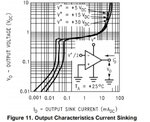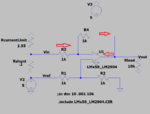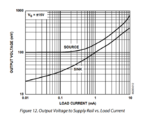Hawaslsh
Full Member level 3
- Joined
- Mar 13, 2015
- Messages
- 164
- Helped
- 5
- Reputation
- 10
- Reaction score
- 7
- Trophy points
- 1,298
- Location
- Washington DC, USA
- Activity points
- 3,422
Edit: OMG: Rail to Rail, not rain to rain!!!!!!!
Hello,

I am working to design a current limiting circuit for a power supply board. In order to monitor the current, I planning on monitoring the voltage across a 0.1 Ohm current shunt using a differential amplifier. The circuit above shows what I have simulated. The left side of the circuit shows the current shunt and a current limiting resistor setting the 3A limit. This setup should give me an output ~ 300 mV, but the real output is ~800mV. This is definitely a rail issue due to the cheapo LM358 but I had a few questions about this.

I adjusted the supply for the op-amp to be well above the voltages on either side of the current shunt, however, the output still sat at the 800mV. why didn't this solve the problem?

Further confusing me: I added gain to the circuit with the increased supply voltage circuit, and it worked? I got the expected 300mV * 10 = 3V ?
Most of these issues can be solved with a better rail to rail op-amp, but clearly I am missing something fundamental to op-amps here.
Thanks for any and all help,
Sami
Hello,
I am working to design a current limiting circuit for a power supply board. In order to monitor the current, I planning on monitoring the voltage across a 0.1 Ohm current shunt using a differential amplifier. The circuit above shows what I have simulated. The left side of the circuit shows the current shunt and a current limiting resistor setting the 3A limit. This setup should give me an output ~ 300 mV, but the real output is ~800mV. This is definitely a rail issue due to the cheapo LM358 but I had a few questions about this.
I adjusted the supply for the op-amp to be well above the voltages on either side of the current shunt, however, the output still sat at the 800mV. why didn't this solve the problem?
Further confusing me: I added gain to the circuit with the increased supply voltage circuit, and it worked? I got the expected 300mV * 10 = 3V ?
Most of these issues can be solved with a better rail to rail op-amp, but clearly I am missing something fundamental to op-amps here.
Thanks for any and all help,
Sami



